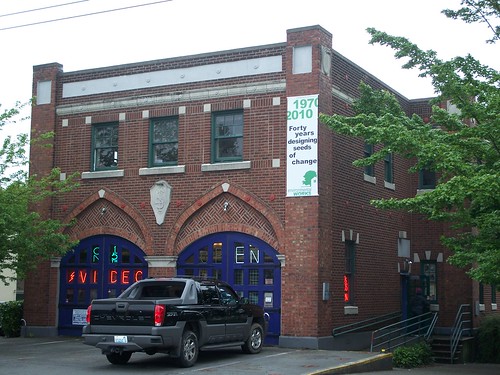
It’s a challenge for many low-income communities and non-profit service providers to afford the architecture and urban planning services necessary for most any real estate development project. That’s where Capitol Hill’s Environmental Works comes in. In 2010, the non-profit organization is celebrating its 40th anniversary of providing affordable architecture and planning services to some of the Seattle region’s neediest populations.
The festivities kicked off on April 22, also the 40th anniversary of Earth Day, right in front of EW’s home at the converted firehouse on 15th Avenue East. “We held an outdoor event, kind of an architectural lemonade stand,” said executive director Daniel Glenn. “We wanted to let people know we’re here and what we do.” Glenn estimated that approximately 100 people attended the event. Commemoration of the organization’s four decades of service will continue through the year with a traveling exhibit showcasing its work. The exhibit will circulate through Seattle community centers, libraries, and possibly City Hall.
EW was formed 40 years ago by UW professor Bob Small and students in response to urban renewal programs taking hold across the nation. These controversial initiatives aimed to improve the quality of life in urban areas through the dubious practice of bulldozing and rebuilding entire neighborhoods. At that time, several similar community design centers were established in architecture and urban planning programs at universities nationwide. As EW evolved, it moved in a different direction from other community design centers nationally in that it began operating primarily as an architectural design studio.
The organization soon took root in Capitol Hill at the firehouse, which it renovated, initially sharing the building with affordable housing developer Capitol Hill Housing and Country Doctor community health center. While the other two have since relocated in the neighborhood, the three still share ownership of the firehouse.
EW specializes in designing spaces for clients that typically cannot afford other firms’ services. Since 1970, EW has carved out its own unique niche in designing affordable housing, childcare centers, and community centers, and its portfolio also includes some single-family houses. “Our clients really are our life blood,” said Glenn, who joined the organization a year-and-a-half ago after a stint at another community design center affiliated with Arizona State University. In addition to its direct architectural design work, EW helped write the Washington State guidelines for the design of childcare centers.
EW is an expert in sustainable design, and its primary green strategies include conserving resources, designing healthy interior environments, and carefully adapting buildings to their sites’ natural and cultural conditions. The organization’s Trugott Terrace project in Belltown is the first affordable housing development in the country to earn LEED certification, a designation that recognizes the use of sustainable building practices. Other recent projects include the design of a childcare center in Wallingford and two community centers for the Neighborhood House organization in High Point and Rainier Vista.
Going green while serving primarily low-income clients has proven to be complex. “It is a serious challenge to do green buildings on a tighter budget,” Glenn said. However, he does see signs of hope. “With the Obama administration, there’s been more funding available for green strategies in affordable housing and for facilities serving lower-income people,” he said.
In fact, he said that EW is doing particularly well despite the ripple effects of the economic downturn on architecture firms. “We have a true advantage in competing against some of the more recognized firms in that we have certain expertise in affordable housing, community facilities, and childcare,” Glenn said. The firm has added five new staff members in just the past year.
A major initiative for the organization in the year ahead will be to encourage the reinstatement of the Community Facilities Architectural Assistance Program, which enabled the organization to provide free design services to community organizations. Funding for the program was cut three years ago. Glenn hopes to demonstrate to Seattle city officials that this initiative was a good investment for city dollars. Over a nine-year period, he said, a $1.5 million investment in feasibility studies has leveraged more than $32 million dollars in non-city funds for capital improvements.
Glenn also seeks to expand EW’s fundraising strategy to attract more individual donations and foundation grants. Most of EW’s funding currently comes from fee-for-service work for clients. Additional funding would allow the organization to expand its work in advocacy, research and education, and free design services.


